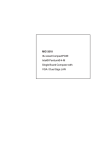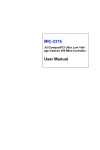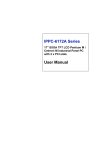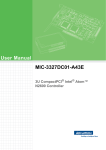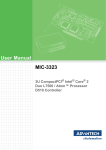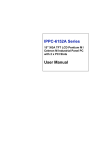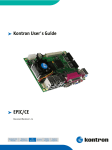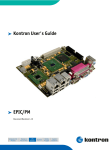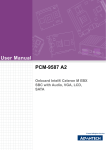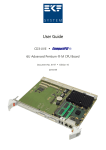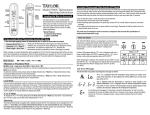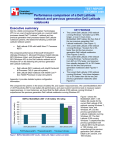Download Intel 3U User's Manual
Transcript
MIC-3321 3U CompactPCI Pentium M 760 2.0G High-performance Controller User Manual Copyright Notice This document is copyrighted, 2004. All rights are reserved. The original manufacturer reserves the right to make improvements to the products described in this manual at any time without notice. No part of this manual may be reproduced, copied, translated or transmitted in any form or by any means without the prior written permission of the original manufacturer. Information provided in this manual is intended to be accurate and reliable. However, the original manufacturer assumes no responsibility for its use, nor for any infringements upon the rights of third parties which may result from its use. Acknowledgements Award is a trademark of Award Software International, Inc. Fast EtherChannel (FEC) is a trademark of Cisco Systems, Inc. Intel, Pentium, and Celeron are trademarks of Intel Corporation. Windows is a registered trademark of Microsoft Corporation. NetWare is a trademark of Novell, Inc. Symbios is a trademark of Symbios Logic Corporation. PICMG, CompactPCI and the PICMG, and CompactPCI logos are trademarks of the PCI Industrial Computers Manufacturers Group. All other product names or trademarks are properties of their respective owners. MIC-3321 User Manual Part No. 2003332100 1st Edition Printed in Taiwan June 2006 ii Product Warranty Advantech warrants to you, the original purchaser, that each of its products will be free from defects in materials and workmanship for two years from the date of purchase. This warranty does not apply to any products which have been repaired or altered by persons other than repair personnel authorized by Advantech, or which have been subject to misuse, abuse, accident or improper installation. Advantech assumes no liability under the terms of this warranty as a consequence of such events. Because of Advantech’s high quality-control standards and rigorous testing, most of our customers never need to use our repair service. If an Advantech product is defective, it will be repaired or replaced at no charge during the warranty period. For out-of-warranty repairs, you will be billed according to the cost of replacement materials, service time and freight. Please consult your dealer for more details. If you think you have a defective product, follow these steps: 1. Collect all the information about the problem encountered. (For example, CPU speed, Advantech products used, other hardware and software used, etc.) Note anything abnormal and list any onscreen messages you get when the problem occurs. 2. Call your dealer and describe the problem. Please have your manual, product, and any helpful information readily available. 3. If your product is diagnosed as defective, obtain an RMA (return merchandize authorization) number from your dealer. This allows us to process your return more quickly. 4. Carefully pack the defective product, a fully-completed Repair and Replacement Order Card and a photocopy proof of purchase date (such as your sales receipt) in a shippable container. A product returned without proof of the purchase date is not eligible for warranty service. 5. Write the RMA number visibly on the outside of the package and ship it prepaid to your dealer. CE Notification The MIC-3321, developed by Advantech CO., LTD., has passed the CE test for environment specification when shielded cables are used for external wiring and sleeve core clamps are added to the USB cables. We recommend the use of shielded cables and sleeve core clamps. iii Technical Support and Assistance Step 1. Visit the Advantech web site at www.advantech.com/support where you can find the latest information about the product. Step 2. Contact your distributor, sales representative, or Advantech's customer service center for technical support if you need additional assistance. Please have the following information ready before you call: - Product name and serial number - Description of your peripheral attachments - Description of your software (operating system, version, application software, etc.) - A complete description of the problem - The exact wording of any error messages Packing List Before setting up the system, check that the items listed below are included and in good condition. If any item does not accord with the table, please contact your dealer immediately. • One MIC-3321 all-in-one single board computer • One utility CD-ROM • This user’s manual If any of these items are missing or damaged, contact your distributor or sales representative immediately. Safety Precaution - Static Electricity Follow these simple precautions to protect yourself from harm and the products from damage. 1. To avoid electrical shock, always disconnect the power from your PC chassis before you work on it. Don't touch any components on the CPU card or other cards while the PC is on. 2. Disconnect power before making any configuration changes. The sudden rush of power as you connect a jumper or install a card may damage sensitive electronic components. MIC-3321 User Manual iv Contents Chapter 1 Hardware Configuration ................................ 2 1.1 1.2 Introduction ....................................................................... 2 Specifications .................................................................... 3 1.3 Function Block Diagram ................................................... 4 1.4 Board Dimensions ............................................................. 5 1.5 Dip Switch Settings........................................................... 5 1.6 Chapter Chapter Standard SBC Functions ................................................ 3 Display ........................................................................... 4 Mechanical and Environmental Specifications .............. 4 Figure 1.1:MIC-3321 Function Block Diagram ............ 4 Figure 1.2:MIC-3321 Board Dimensions ...................... 5 1.5.1 Switch Locations ............................................................ 6 Table 1.1:MIC-3321 Switch Descriptions ..................... 6 Figure 1.3:MIC-3321 S1 Location (1F) ......................... 6 Figure 1.4:MIC-3321 S2 Location (2F) ......................... 7 Safety Precautions ............................................................. 7 2 Connecting Peripherals ................................ 10 2.1 Connectors....................................................................... 10 2.2 Card Installation .............................................................. 13 Figure 2.1:MIC-3321 Connector Locations (1F) ......... 10 Figure 2.2:MIC-3321 Connector Locations (2F) ......... 10 Figure 2.3:MIC-3521 Connectors ................................ 11 Table 2.1:MIC-3321 Connectors Overview ................ 12 Figure 2.4:Chassis Installation/Removal ..................... 14 3 Software Configuration ................................ 16 3.1 3.2 Chapter 1.2.1 1.2.2 1.2.3 Overview ......................................................................... 16 Utilities and Drivers ........................................................ 16 3.2.1 3.2.2 3.2.3 Intel Chipset Software Installation Utility ................... 16 Intel VGA Graphics Driver .......................................... 16 Intel Gigabit LAN Driver ............................................ 16 4 Award BIOS Setup........................................ 18 4.1 Introduction ..................................................................... 18 4.2 Entering Setup ................................................................. 18 Figure 4.1:Setup Program Initial Screen ...................... 18 4.2.1 4.2.2 4.2.3 4.2.4 Standard CMOS Setup ................................................. 19 Figure 4.2:Standard CMOS Setup Screen. .................. 19 Advanced BIOS Features Setup .................................. 20 Figure 4.3:Advanced BIOS features setup screen ....... 20 Advanced Chipset Features Setup ............................... 24 Figure 4.4:Advanced Chipset Features setup screen ... 24 Integrated Peripherals .................................................. 26 Figure 4.5:Integrated Peripherals Setup ....................... 26 v Table of Contents 4.2.5 PNP/PCI Configuration Setup ..................................... 29 Figure 4.6:PNP/PCI configuration screen ................... 29 4.2.6 PC Health Status .......................................................... 30 Figure 4.7:PC Health Status setup screen .................... 31 4.2.7 Spread Spectrum Control ............................................ 32 Figure 4.8:PC Health Status setup screen .................... 32 4.2.8 Load Optimized Defaults ............................................. 32 4.2.9 Set Password ................................................................ 33 4.2.10 Save & Exit Setup ........................................................ 34 4.2.11 Exit Without Saving ..................................................... 34 Appendix A Watchdog Timer Programming................... 36 Appendix B Pin Assignment .............................................. 38 Table B.1:MIC-3321 Connectors Overview ................ 38 B.1 CompactFlash Interface................................................... 39 B.2 USB 2.0 Ports.................................................................. 40 B.3 B.4 VGA Connector............................................................... 40 COM port ........................................................................ 41 B.5 PS/2 Keyboard and Mouse Connector ............................ 41 B.6 Ethernet 10/100/1000Base-T RJ-45 Connector .............. 42 B.7 Secondary IDE 44-pin 2mm Conn. ................................. 42 B.8 Serial ATA0 (7pin connector)......................................... 44 Table B.2:CompactFlash Interface Pin Definitions ..... 39 Table B.3:USB 1.1 Ports Pin Definitions .................... 40 Table B.4:COM Port Pin Definitions .......................... 41 Table B.5:PS/2 Keyboard & Mouse Port Pins ............. 41 Table B.6:Ethernet Connector Definitions .................. 42 MIC-3321 User Manual Table B.7:Secondary IDE Connectors (2.5" HDD) ..... 43 vi CHAPTER 1 22 Hardware Configuration Chapter 1 Hardware Configuration 1.1 Introduction MIC-3321 is a 3U, all-in-one, controller board, compliant with PICMG 2.0 R2.1 CompactPCI specifications. For high computing performance, MIC-3321 uses an Intel Pentium M 760 2.0GHz CPU and Intel 915GM chipset. This CPU provides high performance with its on-chip 2 MB L2 cache and is delivered in a Micro-FCBGA 479 package. MIC-3321 offers powerful functions on a 3U-sized board for performance-demanding applications like real-time machine control and industrial automation. Compact Mechanical Design In order to decrease the thermal effect, Advantech provides a heat sink specially designed for the MIC-3321, so it only needs external cooling air from the chassis fans for ventilation. Ordering Information • MIC-3321S: Pentium M 2.0GHz, 2Mbyte L2 cache,512Mbyte soldered DDR2 SDRAM, 4HP width • MIC-3321: Pentium M 2.0GHz, 2Mbyte L2 cache,512Mbyte soldered DDR2 SDRAM, 8HP width • MIC-3321CS: Celeron M 1.0GHz, 512Kbyte L2 cache,512Mbyte soldered DDR2 SDRAM, -25~70° C, 4HP width • MIC-3321C: Celeron M 1.0GHz, 512Kbyte L2 cache, 512Mbyte soldered DDR2 SDRAM, -25~70°c, 8HP width • MIC-3321LS: Celeron M 800MHz, 0Kbyte L2 cache, 256Mbyte soldered DDR2 SDRAM, 4HP width • MIC-3521-AE: MIC-3321 User Manual Rear I/O Transition Board for MIC-3321 series 2 1.2 Specifications 1.2.1 Standard SBC Functions • CPU: MIC-3321 supports Intel Pentium M 2.0 GHz • Optional: Celeron M 1.0GHz/ Celeron M 800MHz (non cache) • BIOS: Award 4 Mb flash memory • Chipset: Intel 915GM Graphics and Memory Controller Hub (GMCH) Intel 82801FBM I/O Controller Hub (ICH6M) • System Memory: Directed Soldered 512MB DDR2 533 SDRAM (MIC-3321/3321S) Directed Soldered 512MB DDR2 400 SDRAM (MIC-3321C/3321CS) Directed Soldered 256MB DDR2 400 SDRAM (MIC-3321LS) Max:1GB • P-IDE: One Channel IDE CompactFlash socket type II*1(select master/slave DIP-SW), UltraDMA/100/66/33*a (2.5"HDD) • SATA: One external SATA Connector • Serial Ports: Two RS-232 ports with 16C550UARTs (or compatible) with 16-byte FIFO buffer. One Front I/O, the other Rear I/O. • Keyboard and PS/2 Mouse Connector: One 6-pin mini-DIN connector is located on the mounting bracket for easy connection to a keyboard or PS/2 mouse. • USB Port: Four USB2.0 Channels up to 480MB, 2 front I/O, 2 rear I/O • PCI-to-PCI Bridge: PERICOM P17C8150-32-bit/33MHz CompactPCI interface • Watchdog Timer: Provides system reset and software control. Time interval is programmable from 1 to 255 seconds/minutes. • Ethernet LAN: 10/100/1000Base-TX Gigabit Ethernet • Controller Chips: Two Intel 825723E/L PCI Express Gigabit Ethernet Controllers support Pre-boot Execution Environment(PXE). • Battery-backup RAM: 512 KB • Input /Output Bus Interface: PCI 2.2 compliant, 32 bit/33 MHz • CompactPCI Compliance: PICMG 2.1 CompactPCI Hot Swap R3.0 3 Chapter 1 1.2.2 Display • Controller: Intel Graphics Media Accelerator 900 • VRAM: DVMT3.0 128MB • Resolution: Up to 2048x1536 with 32-bit color at 75Hz 1.2.3 Mechanical and Environmental Specifications • Board Size (W x H) : 160 x 100 mm (3U) • Operating Temperature:0 ~ 50° C (MIC-3321 Pentium M 2.0GHz) 0~50° C (MIC-3321LS Celeron M 800MHz) -25 ~ 70° C (MIC-3321C Celeron M 1.0G) • Storage Temperature: -40 ~ 80° C • Board Weight: 0.6 kg 1.3 Function Block Diagram Figure 1.1: MIC-3321 Function Block Diagram MIC-3321 User Manual 4 1.4 Board Dimensions 160 mm 100 mm Figure 1.2: MIC-3321 Board Dimensions 1.5 Dip Switch Settings Since MIC-3321 is composed of one main board and one daughter board, for ease of understanding and a convenient naming, we will use 1F (1st level) to represent the main board, and 2F (2nd level) to represent the daughter board hereafter in this manual. Before setting the switches, you need to disassemble the MIC-3321 to 1F and 2F as in Figures 1.3 and 1.4. 5 Chapter 1 1.5.1 Switch Locations Table 1.1 lists the switch functions of MIC-3321 (be sure that the switch is white one). Figure 1.3 and Figure 1.4 show the locations of S1 and S2, respectively. Table 1.1: MIC-3321 Switch Descriptions DIP-SW Mode Setting Function 1F-S1 Mode Bit-1 : ON LAN1 on Rear I/O Bit-2 : OFF CF : Slave Bit-1 : OFF LAN1 on Front I/O Bit-2 : ON CF : Master 2F-S2 Mode Bit-1 : ON LAN2 on Rear I/O Bit-2 : OFF N/C Bit-1 : OFF LAN2 on Front I/O Bit-2 : ON N/C Figure 1.3: MIC-3321 S1 Location (1F) MIC-3321 User Manual 6 Figure 1.4: MIC-3321 S2 Location (2F) 1.6 Safety Precautions Follow these simple precautions to protect yourself and the products. 1. To avoid electrical shock, always disconnect the power from your PC chassis before you work on it. Don't touch any components on the CPU card or other cards while the PC is on. 2. Disconnect power before making any configuration changes. The sudden rush of power as you adjust a switch or install a card may damage sensitive electronic components. 3. Always ground yourself to remove any static charge before you touch your CPU card. Be particularly careful not to touch the chip connectors. Modern integrated electronic devices, especially CPUs and memory chips, are extremely sensitive to static electrical discharges and fields. Keep the card in its antistatic packaging when it is not installed in the PC, and place it on a static dissipative mat when you are working with it. Wear a grounding wrist strap for continuous protection. 7 Chapter 1 MIC-3321 User Manual 8 CHAPTER 2 22 Connecting Peripherals Chapter 2 Connecting Peripherals 2.1 Connectors Figure 2.1 and 2.2 show MIC-3321 connector locations. Figure 2.3 shows MIC-3521 connector location. Figure 2.1: MIC-3321 Connector Locations (1F) Figure 2.2: MIC-3321 Connector Locations (2F) MIC-3321 User Manual 10 Figure 2.3: MIC-3521 Connectors 11 Chapter 2 Table 2.1: MIC-3321 Connectors Overview Number Function Description 1F-CN1 USB1 USB1 Type-A Female on Front side panel. 1F-CN3 USB2 USB2 Type-A Female on Front side panel. 1F-CN2 CF CompactFlash socket 1F-CN5 VGA D-Sub 15-pin (Female) on Front side panel. 1F-RJ1 LAN1 10/100/1000Base-TX Ethernet on Front side panel. 1F-S1 LAN1 MODE, CF MODE Bit-1 Setting: LAN1 Front I/O or Rear I/O Bit-2 Setting: CF master or slave mode 2F-CN7 COM1 Serial port: RS-232 on Front I/O 2F-CN8 PS2 Standard Mini-DIN 6-pin supports K/B and Mouse on Front I/O. 2F-CN10 PATA Internal IDE 44pin(2mm) 2.5îHDD connector 2F-SA1 SATA Serial ATA0 (7pin connector) 2F-RJ2 LAN2 10/100/1000Base-TX Ethernet on Front side panel. 2F-S2 LAN2 MODE Bit-1 Setting: LAN2 Front I/O or Rear I/O Bit-2 Setting: N/C 1R-CN1 COM2 Serial port2: RS-232 on Rear I/O 1R-CN2 USB3 USB3 Type-A Female on Rear I/O 1R-CN3 USB4 USB4 Type-A Female on Rear I/O 1R-CN4 VGA D-Sub 15-pin (Female) on Rear I/O 1R-CN5 PS2 Standard Mini-DIN 6-pin supports K/B and Mouse on Rear I/O 1R-RJ1 LAN1 10/100/1000Base-TX Ethernet on Rear I/O 1R-RJ2 LAN2 10/100/1000Base-TX Ethernet on Rear I/O MIC-3321 User Manual 12 2.2 Card Installation The CompactPCI connectors are firm and rigid, but require careful handling while plugging and unplugging. Improper installation of a card can easily damage the backplane of the chassis. The inject/eject handle of MIC-3321 helps you install and remove the card easily and safely. Follow the procedure below to install the MIC3321 into a chassis: To install a card: 1. Hold the card vertically. Be sure that the card is pointing in the correct direction. The components of the card should be pointing to the right-hand side. 2. Holding the lower handle, pull out the red portion in the middle of the handle to unlock it. Caution: Keep your fingers away from the hinge to prevent them from getting pinched. 3. Insert the card into the chassis by sliding the upper and lower edges of the card into the card guide. 4. Push the card into the slot gently by sliding the card along the card guide until the handles meet the rectangular holes of the cross rails. Note: 5. If the card is correctly positioned and has been slid all the way into the chassis, the handle should match the rectangular holes. If not, remove the card from the card guide and repeat step 3 again. Do not try to install a card by forcing it into the chassis. Lift the lower handle up to push the card into place. 13 Chapter 2 To remove a card: 1. Unscrew the four screws on the front panel. 2. Press the lower handle down to release the card from the backplane. 3. Slide the card out. Figure 2.4: Chassis Installation/Removal MIC-3321 User Manual 14 3 CHAPTER 22 Software Configuration Chapter 3 Software Configuration 3.1 Overview MIC-3321 has a CD-ROM with utilities and drivers. Please install the Chipset INF driver, VGA graphics driver, and LAN driver. 3.2 Utilities and Drivers The following utilities and drivers are provided with the MIC-3321 series. You can also find updated description of the utilities and drivers in the ReadMe.txt file on the CD-ROM. Windows 2000/XP are fully supported by the MIC-3321 series. 3.2.1 Intel Chipset Software Installation Utility Path: Driver\Inf\I915GM Available for the operating systems listed below: • Microsoft Windows 2000 • Microsoft Windows XP 3.2.2 Intel VGA Graphics Driver Path: Driver\VGA\915GM\ Available for the operating systems listed below: • Microsoft Windows 2000 • Microsoft Windows XP 3.2.3 Intel Gigabit LAN Driver Path: \Driver\Lan\82573E\ Available for the operating systems listed below: • Microsoft Windows 2000 • Microsoft Windows XP MIC-3321 User Manual 16 4 CHAPTER 22 Award BIOS Setup Chapter 4 Award BIOS Setup 4.1 Introduction Once you enter the Award BIOS CMOS Setup Utility, the Main Menu (Figure 4-1) will appear on the screen. The Main Menu allows you to select between nine setup functions and two exit choices. Use the arrow keys to select among the items and press <Enter> to accept or enter the submenu. Figure 4.1: Setup Program Initial Screen Award's BIOS ROM has a built-in Setup program that allows users to modify the basic system configuration. This type of information is stored in battery-backed CMOS so that it retains the Setup information when the power is turned off. 4.2 Entering Setup Turn on the computer and press <Del> to allow you to enter the BIOS setup. (Figure 4.1) MIC-3321 User Manual 18 4.2.1 Standard CMOS Setup Figure 4.2: Standard CMOS Setup Screen. Date The date format is <week>, <month>, <day>, <year>. Time The time format is <hour> <minute> <second>, based on the 24-hour clock. IDE Primary Master/ Secondary Master/ Secondary Slave IDE HDD Auto-Detection: Press “Enter” to select this option for automatic device detection. IDE Device Setup: Auto: Automatically detects IDE devices during POST None: Select this when no IDE device is used. The system will skip the auto-detection step to make system start up faster. 19 Chapter 4 Halt On This category determines whether system start-up will halt when an error is detected during power up. The options are: No Errors/All Errors/All, But Keyboard/All, But Diskette/ All, But Disk/Key Memory This category displays base, extended, and total memory detected during the POST (Power On Self Test). 4.2.2 Advanced BIOS Features Setup The "Advanced BIOS FEATURES" screen will appear after the BIOS FEATURES SETUP item from the CMOS SETUP UTILITY Menu was chosen. This screen allows the user to configure the board according to particular requirements. Below are some major items that are provided in the BIOS FEATURES SETUP screen: Figure 4.3: Advanced BIOS features setup screen MIC-3321 User Manual 20 Hard Disk Boot Priority Set hard disk boot device priority. CPU Thermal Monitor The Intel Thermal MonitorAutomatic Mode. There are two Automatic modes called Intel Thermal Monitor 1 (TM1) and Intel Thermal Monitor 2 (TM2). And MIC-3321 Auto dete C-M or P-M.When CPU was C-M BIOS running in TM1,another running TM2. TM1: When Intel Thermal Monitor 1 is enabled, and a high temperature situation exists, the clock will be modulated by alternately turning the clock off and on at a 50% duty cycle. Cycle times are processor speed dependent, and will decrease linearly as processor core frequencies increase. After the temperature has returned to a non-critical level, modulation ceases and the TCC goes inactive. TM2: When Intel Thermal Monitor 2 is enabled, and a high temperature situation exists, the processor will perform an Enhanced Intel SpeedStep technology transition to a lower operating point. When the processor temperature drops below the critical level, the processor will make an Enhanced Intel SpeedStep technology transition to the last requested operating point. Intel Thermal Monitor 2 is the recommended mode on the Intel Pentium M processor Enabled (default) Enable Thermal Monitor Disabled Disable Thermal Monitor Virus Warning This will occur during and after the system boot up, or during any attempt to sector or partition the hdd. While the message displays, an anti-virus program will attempt to locate the problem. If the Virus Warning is disabled, no warning message will ever appear. 21 Chapter 4 CPU L1 & L2 Cache Enabled (default) Disabled Enable cache Disable cache Note: The internal cache is built into the processor. Quick Power On Self Test This category speeds up Power On Self Test (POST) after you power on the computer. If this is set to Enabled, BIOS will shorten or skip some check items during POST. Enabled (default) Enable quick POST Disabled Normal Normal POST First/Second/Third Boot Device and Boot Other Device The BIOS attempts to load the operating system from the devices in the sequence selected in these items. The settings are Hard Disk, CDROM, USB-FDD, USB-ZIP, USB-CD-ROM, LAN 1, LAN 2 and Disabled. First boot device (default) USB-CD-ROM Second boot device Hard Disk Third boot device CD-ROM Note: When you boot by USB-CD-ROM, please install WinXP with SP1 or Win 2000 with SP3. Boot Up NumLock Status On (default): Keypad: numeric keys Off: Keypad: arrow keys Gate A20 Options Normal: A20 signal is controlled by keyboard or chipset hardware. Fast (default): A20 signal is controlled by port 92 or chipset method MIC-3321 User Manual 22 Typematic Rate Setting Keystrokes repeat at a rate determined by the keyboard controller. When enabled, the typematic rate and typematic delay can be selected. The settings are: Enabled/Disabled. The default setting is Disabled. Typematic Rate (Chars/Sec) Set the number of times a second to repeat a keystroke key down. The settings are: 6, 8, 10, 12, 15, 20, 24, 30. Typematic Delay (Msec) Sets the delay time after the key is held down before it the keystroke. The settings are: 250, 500, 750, 1000. Security Option This category allows you to limit access to the system and/or to Setup. Setup(default) The system will boot, but access to Setup will be denied if the correct password is not entered at the prompt. System The system will not boot and access to Setup will be denied if the correct password is not entered at the prompt. OS Select For DRAM > 64MB Allows OS2 to be used with > 64 MB of DRAM. Settings are Non-OS/2 (default) and OS2. Set to OS/2 if using more than 64MB and running OS/ 2. 23 Chapter 4 4.2.3 Advanced Chipset Features Setup The Advanced Chipset Features Setup option is used to change the values of the chipset registers. These registers control most of the system options in the computer. Choose the "Advanced Chipset Features" from the main menu and the following screen will appear. Figure 4.4: Advanced Chipset Features setup screen DRAM Timing Configuration This field lets you select system memory timing data. Manual and BY SPD are two options. Default is "BY SPD" CAS Latency Time When synchronous DRAM is installed, the number of clock cycles of CAS latency depends on the DRAM timing. The settings are: 3,4,5 and Auto. MIC-3321 User Manual 24 DRAM RAS# to CAS# Delay This field is used to insert a timing delay between the CAS and RAS strobe signals, used when DRAM is written to, read from, or refreshed. Fast gives faster performance; and Slow gives more stable performance. This field applies only when synchronous DRAM have been installed in the system. The settings are: 2,3,4,5 and auto. DRAM RAS# Precharge If an insufficient number of cycles is allowed for the RAS to accumulate its charge before DRAM refresh, the refresh may be incomplete and the DRAM may fail to retain data. Fast gives faster performance; and Slow gives more stable performance. This field applies only when synchronous DRAM is installed in the system. The settings are: 2,3,4,5 and Auto. Precharge delay (tRAS) If an insufficient number of cycles is allowed for the RAS to accumulate its charge before DRAM refresh, the refresh may be incomplete and the DRAM may fail to retain data. Fast gives faster performance; and Slow gives more stable performance. This field applies only when synchronous DRAM is installed in the system. The settings are: Auto and 2,3,4,5,6,7,8,9,10 System Memory Frequency Default auto :The bios detect memory frequency is by SPD. The settings are: Auto and 333MHz,400MHz,533MHz. System BIOS Cache-able Selecting Enabled allows caching of the system BIOS ROM at F0000hFFFFFh, resulting in better system performance. However, if any program writes to this memory area, a system error may result. The settings are: Enabled (Default) and Disabled. Video BIOS Cacheable Select Enabled allows caching of the video BIOS, resulting in better system performance. However, if a program writes to this area, a system error may result. The settings are: Enabled and Disabled (Default). 25 Chapter 4 Memory Hole At 15M-16M You can reserve this area of system memory for ISA adapter ROM. When this area is reserved, it cannot be cached. The user information of peripherals that need to use this area of system memory usually discusses their memory requirements. The settings are: Enabled and Disabled (Default). PCI-E Compliancy Mode This allows the user to select the PCI-E compliant mode. The options are [v1.0], and [v1.0a]. On-Chip Video Memory Size This field let you select On-Chip buffer size. The settings are: 1 and 8. DVMT Mode We have three options (Fixed, DVMT and Both). The default is DVMT. DVMT/FIXED memory Size We have 64Mb and 128MB. The default is 128MB. 4.2.4 Integrated Peripherals Figure 4.5: Integrated Peripherals Setup MIC-3321 User Manual 26 IDE HDD Block Mode Block mode is also called block transfer, multiple commands, or multiple sector read/write. If your IDE hard drive supports block mode (most new drives do), select Enabled for automatic detection of the optimal number of block read/writes per sector the drive can support. The settings are: Enabled (Default), Disabled. On-Chip Primary (SATA) / Secondary (PATA) PCI IDE The integrated peripheral controller contains an IDE interface with support for two IDE channels. Select Enabled to activate each channel separately. The settings are: Enabled (Default) and Disabled. IDE Primary/Secondary Master/Slave PIO The four IDE PIO (Programmed Input/Output) fields let you set a PIO mode (0-4) for each of the four IDE devices that the onboard IDE interface supports. Modes 0 through 4 provide successively increased performance. In Auto mode, the system automatically determines the best mode for each device. The settings are: Auto (Default), Mode 0, Mode 1, Mode 2, Mode 3, Mode 4. IDE Primary/Secondary Master/Slave UDMA Ultra DMA/33 implementation is possible only if your IDE hard drive supports it and the operating environment includes a DMA driver (Windows 95 OSR2 or a third-party IDE bus master driver). If your hard drive and your system software both support Ultra DMA/33 and Ultra DMA/66 and Ultra DMA/100, select Auto to enable BIOS support. The settings are: Auto (Default), Disabled. Note: Because CF Socket and 2.5”HDD Connector are the same IDE Channel (PATA).CF and HDD had a lot of Compatibility issues of timing and loading effect, when you need two devices in MIC3321.Setting IDE HDD Block Mode and Secondary Master/Slave UDMA Disabled.You must test compatibility in your system. 27 Chapter 4 USB Controller Select enabled if your system contains a Universal Serial Bus (USB) 1.1 controller. The settings are: Enabled (Default), Disabled. USB 2.0 Controller Select enabled if your system contains a Universal Serial Bus (USB) 2.0 controller. The settings are: Enabled (Default), Disabled. USB Keyboard Support Select enabled if you use USB Keyboard in DOS mode. Enable (Default) USB Mouse Support Select enabled if you use USB Mouse in DOS mode. Disabled (Default) AC97 Audio Select “Disable” if you do not want to use AC-97 audio. Options are “Auto”, and “Disabled”. Onboard LAN1 Control Options are “Enabled” and “Disabled”. Select “Disabled” if you don’t want to use onboard LAN controller1. Onboard LAN2 Control Options are “Enabled” and “Disabled”. Select Disabled if you don’t want to use the onboard LAN controller2. Onboard Serial Port 1 The settings are “3F8/IRQ4”, “2F8/IRQ3”, “3E8/IRQ4”, “2E8/IRQ3”, and “Disabled” for the onboard serial connector. Onboard Serial Port 2 The settings are “3F8/IRQ4”, “2F8/IRQ3”, “3E8/IRQ4”, “2E8/IRQ3”, and “Disabled” for the onboard serial connector. MIC-3321 User Manual 28 4.2.5 PNP/PCI Configuration Setup This section describes configuring the PCI bus system. PCI, or Personal Computer Interconnect, is a system that allows I/O devices to operate at speeds nearing the speed the CPU itself uses when communicating with its own special components. This section covers some very technical items and it is strongly recommended that only experienced make any changes to the default settings. Figure 4.6: PNP/PCI configuration screen Init Display Fiest The Default is PCI Slot.Select PCI Slot to boot VGA in extended VGA Card. Reset Configuration Data The default is Disabled. Select Enabled to reset Extended System Configuration Data (ESCD) if you have installed a new add-on card, and system configuration is in such a state that the OS cannot boot. 29 Chapter 4 Resource Controlled By The Award Plug and Play BIOS has the capacity to automatically configure all the boot and Plug and Play compatible devices. However, this capability means absolutely nothing unless you are using a Plug and Play operating system such as Windows 95/98. If you set this field to "manual," choose specific resources by going into each of the sub menus that follow this field (a sub menu is preceded by a "Y"). The settings are: Auto (ESCD) (Default), Manual. IRQ Resources When resources are controlled manually, assign each system interrupt a type, depending on the type of device using the interrupt. PCI/VGA Palette Snoop Leave this field at Disabled. The settings are Enabled, Disabled (Default). Maximum Payload Size This allows you to set the maximum TLP payload size for PCI Express devices. The options are [128 bytes], [256 bytes], [512 bytes], [1024 bytes], [2048 bytes], and [4096 bytes]. 4.2.6 PC Health Status This section shows the Status of you CPU, System Temp, Warning for overall system status. This is only available if there is Hardware Monitor onboard. MIC-3321 User Manual 30 Figure 4.7: PC Health Status setup screen CPU Warning Temperature This item will prevent the CPU from overheating. The choices are “Disabled”, “50C/122F”, “53C/127F”, “56C/133F”, “60C/140F”, “63C/ 145F”, “66C/151F”, “70C/158F”, “75C/167F”, “80C/176F”, “85C/ 185F”, “90C/194F”, and “95C/205F”. Current System/CPU Temp./ Vcore/1.5V/3.3V/5V/12V/-12V/Vbat This shows system health status. 31 Chapter 4 4.2.7 Spread Spectrum Control Figure 4.8: PC Health Status setup screen Spread Spectrum This allows the enable spread spectrum function. Default is "Dis-abled." 4.2.8 Load Optimized Defaults When you press <Enter> on this item, you get a confirmation dialog box with a message similar to: Load Optimized Defaults (Y/N) ? N Pressing 'Y' loads the default values that are factory settings for optimal performance system operations. MIC-3321 User Manual 32 4.2.9 Set Password To change, confirm, or disable the password, choose the "PASSWORD SETTING" option form the Setup main menu and press [Enter]. The password can be at most 8 characters long. Remember, to enable this feature. You must first select the Security Option in the Advanced BIOS Features Setup to be either "Setup" or "System." Pressing [Enter] again without typing any characters can disable the password setting function. 33 Chapter 4 4.2.10 Save & Exit Setup If you select this and press the [Enter] key, the values entered in the setup utilities will be recorded in the CMOS memory of the chipset. The microprocessor will check this every time you turn your system on and compare this to what it finds as it checks the system. This record is required for the system to operate. 4.2.11 Exit Without Saving Selecting this option and pressing the [Enter] key lets you exit the Setup program without recording any new values or changing old ones. MIC-3321 User Manual 34 A APPENDIX 2 Programming the Watchdog Timer Appendix A Watchdog Timer Programming To program the watchdog timer, you must write a program which writes a value to I/O port address 443 (hex). This output value represents time interval. The value range is from 01 (hex) to FF (hex), and the related time interval is 0.25 sec. to 63.75sec. Data Time Interval 01 0.25 sec. 02 0.50 sec. 03 0.75 sec. 04 1.00 sec. •• •• FF 63.75 sec. After data entry, your program must refresh the watchdog timer by rewriting the I/O port 443 (hex) while simultaneously setting it. When you want to disable the watchdog timer, your program should read I/O port 443 (hex). The following shows how to program the watchdog timer in BASIC: 10 REM Watchdog timer example program 20 OUT &H443, data REM Start and restart the watchdog 30 GOSUB 1000 REM Your application task #1, 40 OUT &H443, data REM Reset the timer 50 GOSUB 2000 REM Your application task #2, 60 OUT &H443, data REM Reset the timer 70 X=INP (&H443) REM, Disable the watchdog timer 80 END 1000 REM Subroutine #1, your application task •• •• 1070 RETURN 2000 REM Subroutine #2, your application task •• •• 2090 RETURN. MIC-3321 User Manual 36 B APPENDIX 2 Pin Assignment Appendix B Pin Assignment This chapter shows the pin assignments of MIC-3321 series CPU cards. Table B.1: MIC-3321 Connectors Overview Number Function Description 1F-CN1 USB1 USB1 Type-A Female on Front side panel. 1F-CN3 USB2 USB2 Type-A Female on Front side panel. 1F-CN2 CF CompactFlash socket 1F-CN5 VGA D-Sub 15-pin (Female) on Front side panel. 1F-RJ1 LAN1 10/100/1000Base-TX Ethernet on Front side panel. 1F-S1 LAN1 MODE, CF MODE Bit-1 Setting: LAN1 Front I/O or Rear I/O Bit-2 Setting: CF master or slave mode 2F-CN7 COM1 Serial port: RS-232 on Front I/O 2F-CN8 PS2 Standard Mini-DIN 6-pin supports K/B and Mouse on Front I/O. 2F-CN10 PATA Internal IDE 44pin(2mm) 2.5îHDD connector 2F-SA1 SATA Serial ATA0 (7pin connector) 2F-RJ2 LAN2 10/100/1000Base-TX Ethernet on Front side panel. 2F-S2 LAN2 MODE Bit-1 Setting: LAN2 Front I/O or Rear I/O Bit-2 Setting: N/C 1R-CN1 COM2 Serial port2: RS-232 on Rear I/O 1R-CN2 USB3 USB3 Type-A Female on Rear I/O 1R-CN3 USB4 USB4 Type-A Female on Rear I/O 1R-CN4 VGA D-Sub 15-pin (Female) on Rear I/O 1R-CN5 PS2 Standard Mini-DIN 6-pin supports K/B and Mouse on Rear I/O 1R-RJ1 LAN1 10/100/1000Base-TX Ethernet on Rear I/O 1R-RJ2 LAN2 10/100/1000Base-TX Ethernet on Rear I/O MIC-3321 User Manual 38 B.1 CompactFlash Interface The socket accepts an IDE-compatible CompactFlash memory card. Table B.2: CompactFlash Interface Pin Definitions Pin Signal Pin Signal 1 GND 26 N/C 2 PDD3 27 PDD11 3 PDD4 28 PDD 12 4 PDD5 29 PDD 13 5 PDD6 30 PDD 14 6 PDD7 31 PDD 15 7 PDCS* 32 PDCS* 8 GND 33 N/C 9 GND 34 PDIOR* 10 GND 35 PDIOW* 11 GND 36 CF-36 12 GND 37 IRQ14 13 +5V 38 +5V 14 GND 39 SANMODE 15 GND 40 N/C 16 GND 41 IDERST* 17 GND 42 PDIORDY 18 PDA2 43 N/C 19 PDA1 44 CF-44 20 PDA0 45 CFLED 21 PDD0 46 P66DET 22 PDD1 47 PDD8 23 PDD2 48 PDD9 24 N/C 49 PDD10 25 N/C 50 GND *LOW ACTIVE 39 Appendix B B.2 USB 2.0 Ports Table B.3: USB 1.1 Ports Pin Definitions Pin Signal 1 VCC 2 USB_P- 3 USB_P+ 4 GND B.3 VGA Connector Pin Signal 1 2 3 4 5 6 7 8 9 10 11 12 13 14 15 RED GREEN BLUE N/C GND GND GND GND N/C (VGAVCC) GND N/ C VGA_SDA HSYNC VSYNC VGA_SCL MIC-3321 User Manual 40 B.4 COM port Table B.4: COM Port Pin Definitions PIN RS-232 1 NDCD 2 NRX 3 NTX 4 NDTR 5 GND 6 NDSR 7 NRTS 8 NCTS 9 NRI B.5 PS/2 Keyboard and Mouse Connector PS/2 keyboard and mouse port pin definitions Table B.5: PS/2 Keyboard & Mouse Port Pins Pin Signal 1 KB DATA 2 MS DATA 3 GND 4 VCC 5 KB CLOCK 6 MS CLOCK 41 Appendix B B.6 Ethernet 10/100/1000Base-T RJ-45 Connector Table B.6: Ethernet Connector Definitions Pin Signal 1 TD+ 2 TD- 3 RD+ 4 N/C 5 N/C 6 RD- 7 N/C 8 N/C B.7 Secondary IDE 44-pin 2mm Conn. For direct installation of 2.5" IDE HDD (2F-CN17) For wiring out (2F-CN18) MIC-3321 User Manual 42 Table B.7: Secondary IDE Connectors (2.5" HDD) Pin Signal Pin Signal 1 3 5 7 9 11 13 15 17 19 21 23 25 27 29 31 33 35 37 39 41 43 IDERST* SDD7 SDD6 SDD5 SDD4 SDD3 SDD2 SDD1 SDD0 GND SDDREQ SDIOW* SDIOR* SDIORDY SDDACK* IRQ15 SDA1 SDA0 SDCS*1 HDD_LED +5V GND 2 4 6 8 10 12 14 16 18 20 22 24 26 28 30 32 34 36 38 40 42 44 GND SDD8 SDD9 SDD10 SDD11 SDD12 SDD13 SDD14 SDD15 N/C GND GND GND GND GND N/C S66DET SDA2 SDCS*3 GND +5V N/C *LOW ACTIVE 43 Appendix B B.8 Serial ATA0 (7pin connector) Pin Signal 1 GND 2 TX+ 3 TX- 4 GND 5 RX- 6 RX+ 7 GND MIC-3321 User Manual 44


















































